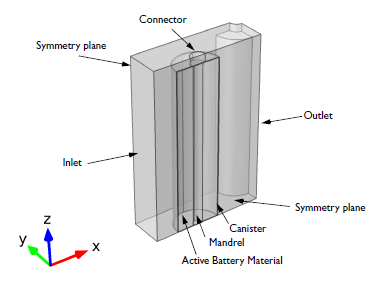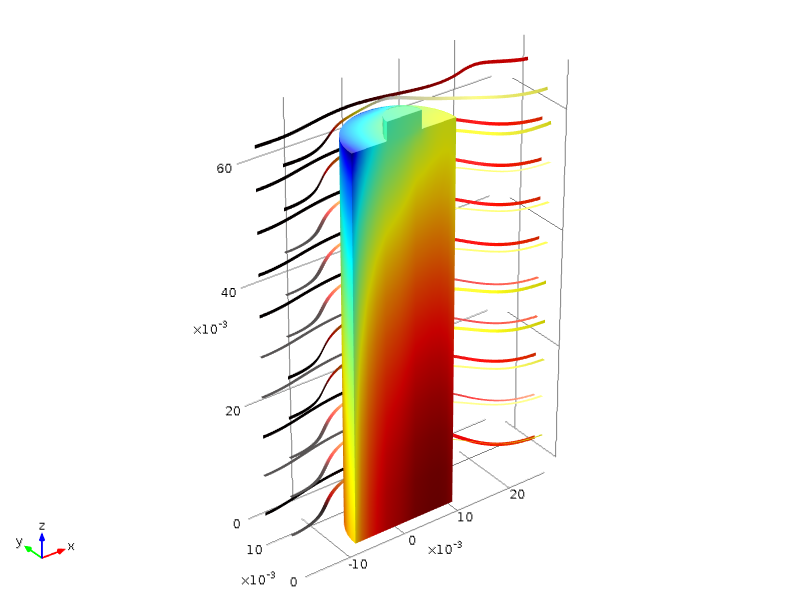
In the performance of lithium-ion batteries, thermal management is an important element to consider. Through modeling and simulation, you can improve the design process by analyzing how heat is transferred within the energy source.
A Cause for Concern
While you may or may not hear the term on a regular basis, lithium-ion batteries certainly play an active role in keeping you connected to others in your day-to-day life. These lightweight, rechargeable batteries are commonly used within various consumer electronics, including laptops and cell phones. With their high energy densities, lithium-ion batteries have even grown in use for industrial and transportation purposes as well.

A lithium-ion battery from a cell phone. (“NOKIA® Battery” by Kristoferb — Own work. Licensed under Creative Commons Attribution-Share Alike 3.0 via Wikimedia Commons.)
As the uses for these devices grow, so does the concern surrounding their safety. As mentioned in a previous blog post, a lithium-ion battery overheated and caught fire last year in a new Boeing 787 Dreamliner, forcing the temporary grounding of all Dreamliner planes. Last year, Design News reported on the overheating of lithium-ion batteries within Mitsubishi vehicles (read their story here).
Two different headlines raising one common issue — the effect heat has on the safety and longevity of lithium-ion batteries.
How Does Heat Impact Lithium-Ion Batteries?
In order to address this concern, it is important to understand the reasoning behind it.
Let’s first begin with the design of the battery. A lithium-ion battery is composed of two electrodes and a nonaqueous electrolyte, which allows for ionic movement. During charging, lithium ions move from the cathode to flow through the electrolyte and then become captured within the crystalline structure of a carbon-based anode. When discharged, the process reverses and these ions flow back, resulting in the reverse electrical flow of current to power the device’s circuit.
As this process, which is similar to electric current flowing through a wire, occurs, internal resistance is created within the electrolyte to bring about Joule heating. In the design of a lithium-ion battery, it is important that this heat disperses quickly enough so that the cell does not reach a high enough temperature for decomposition. As noted in this white paper on modeling the lithium-ion battery, the decomposition reaction is exothermic, meaning that once this process begins, the temperature will continue to rise and feed the decomposition reaction — a phenomenon known as thermal runaway. This spread of heat can be a potential source of fire hazard.
Enhancing Lithium-Ion Battery Design Through Modeling and Simulation
With the help of COMSOL Multiphysics, you can visualize and better understand temperature distribution within a lithium-ion battery. The Thermal Modeling of a Cylindrical Li-ion Battery model from the Batteries & Fuel Cells Module couples heat transfer with the lithium-ion battery chemistry and the flow of ions. The Conjugate Heat Transfer interface is used to investigate the air cooling of this 3D thermal model of a lithium-ion battery.

The components of the thermal model.
The model below shows the battery’s temperature and the flow’s streamlines after 1,500 seconds of charging. The highest temperature is located in the active battery material, toward the end that is thermally insulated. Thus, this area of the cell is more prone to aging and degradation.

Temperature distribution within the Li-ion battery.
Concluding Thoughts — It’s Your Turn
Modeling and simulation are useful resources in optimizing the design of lithium-ion batteries. By analyzing how heat is transferred during the battery’s operation, researchers and manufacturers are able to improve the performance of the battery and pave the way for a safer, longer-lasting technology.
Download the model files and run your own simulations: Thermal Modeling of a Cylindrical Li-ion Battery in 3D



Comments (0)